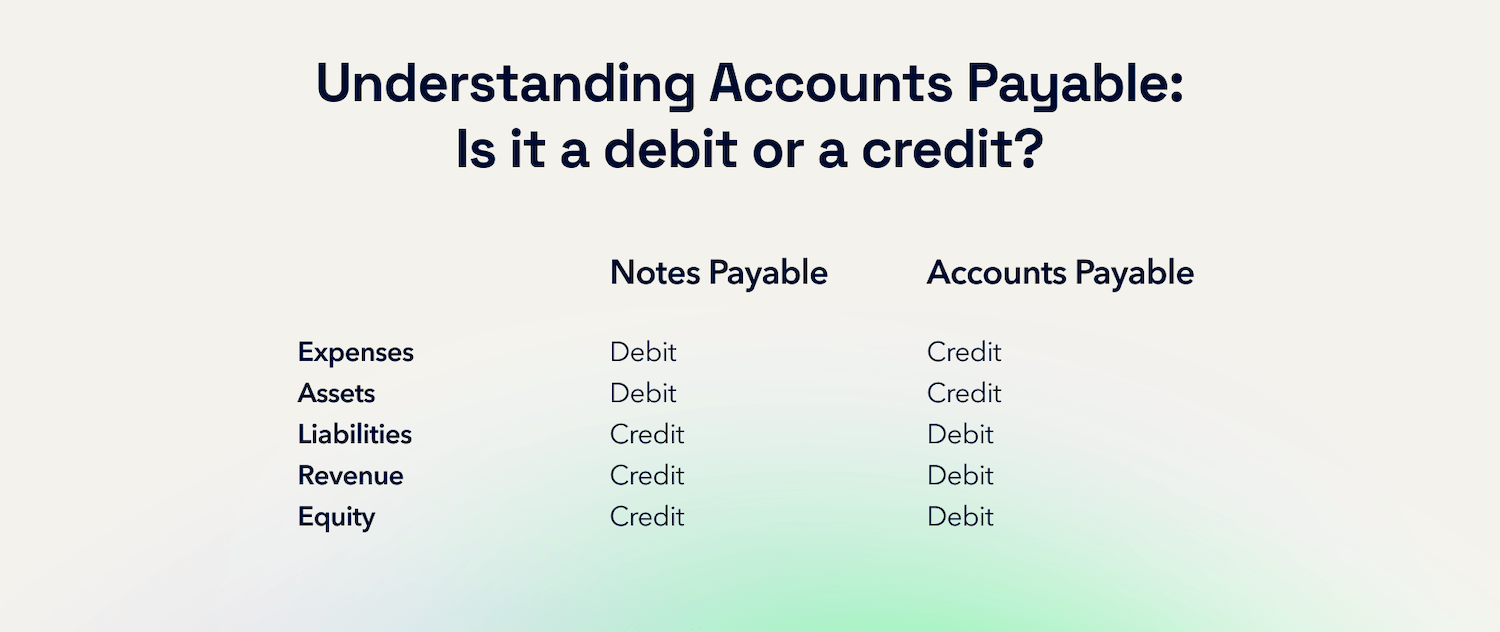
Understanding the role and purpose of accounts payable (AP) is crucial for your company's financial health. Efficiently managing your AP can help you stay on top of payments and have better control of your cash flow.
To fully understand AP you should know how AP functions and is recorded in your accounting books, and how double-entry accounting systems work. In double-entry accounting, each transaction is recorded as a debit and a credit, so keep reading to find out if AP is a debit or credit account and how to record it.
Key takeaways
- Accounts payable is an account that represents money you owe to other parties.
- Accounts payable is a credit account, as it's a liability account.
- Debits and credits are used in double-entry accounting — debits represent an increase in assets and decrease in liabilities, while credits represent an increase in liabilities and a decrease in assets.
- Bills payables, loan payables, and note payables are all liabilities and credit accounts. Credit entries are used to increase their balances.
- Your AP turnover ratio represents how many times you pay off your AP in a given period.
- You can use automation to greatly improve the efficiency of your AP process.
Understanding accounts payable: Is accounts payable a debit or a credit?
Accounts payable (AP) is a credit account. A credit represents an increase in liabilities, equity, or income, or a decrease in assets or expenses.
In double-entry bookkeeping, every transaction has two sides: A debit and credit. Double-entry is an accounting system that is based on an understanding that every transaction has an equal and opposite effect in at least two accounts.
This method is used to keep the accounting equation "Assets = Liabilities + Equity" balanced.
Accounts payable is a liability account, and since liability accounts are recorded as a credit, accounts payable is considered a credit account.
What are debits and credits?
Every time you make a transaction, you need to record two things: a debit and a credit.
Think of it like this: when you record a credit, you're either adding to what you owe (like loans or bills) or reducing what you own (like cash or equipment). On the flip side, when you record a debit, you're doing the opposite: you're either adding to what you own (like buying new supplies) or reducing what you owe to others (like paying off a part of a loan). So, in a nutshell, debits and credits help keep track of your business's money—where it's coming from and where it's going.
Put another way:
- Credits record an amount added or deposited in an account balance. A recorded credit will decrease an asset account or increase a liability account.
- Debits record an amount owed or subtracted from an account balance. Debit entries will increase asset accounts and decrease liability and equity accounts.
Example
For example, if you purchase equipment for your business for $1,000 on credit here is how the transaction would look like:
- $1,000 would be recorded as a debit for the equipment account. The debit will increase the equipment account, as you've added new equipment to your assets.
- $1,000 would also be recorded as a credit in your accounts payable account. The credit will increase your liability account, as you've added an amount as a liability.
Then, once you've made a payment to the vendor, you would credit the cash account (credit decreases an asset account), and debit your AP account (debt will decrease a liability account).
| Increased by | Decreased by | |
| Expenses | Debit | Credit |
| Assets | Debit | Credit |
| Liabilities | Credit | Debit |
| Revenue | Credit | Debit |
| Equity | Credit | Debit |
What is accounts payable?
Accounts payable represents the money you owe.
Your AP account is the amount of money you've gotten in goods and services from suppliers that you haven't paid for. AP is a current liability, as it's a short-term debt, ranging from days to a year.
How is accounts payable different than accounts receivable?
Accounts payable represents money owed in the form of short-term debt. Conversely, accounts receivable represents money owed to you, and is a current asset.
What is the opposite of accounts payable?
The opposite of your account payable is your account receivable. Where AP is a credit account, AR is a debit account.
Is accounts payable a debit or credit in trial balance?
A trial balance is a worksheet where all the ledgers are compiled into debit and credit column totals. This is done to ensure the books are adding up mathematically. On the trial balance, accounts payable is a credit balance.
Further reading: Is accounts payable an asset or liability?

Is a bill payable a debit or credit?
A bill payable is a document showing the amount owing for goods and services purchased on credit. This document can include invoices and bills, and the amount is recorded in the accounts payable account.
The role of a bill payable in bookkeeping is to ensure there are no discrepancies and to forecast future payment obligations.
Bills payable amounts are entered in the AP category on the general ledger, so bills payable are a credit. Simply, bills payable represent liabilities, as they show purchases made on credit, so are credited to AP.
Is a loan payable a debit or credit account?
Loans payable is an account that records the amount of money you've lent from another party. Your loans payable account shows up as a liability on your company's balance sheet.
Like accounts payable, a loan payable is a credit account, as it's a liability account which are recorded as credits.
Here's a simplified process of how transactions of receiving and paying off a loan would look like.
- When you've had a loan approved: Cash is debited the total amount of the loan (increases assets), and the loans payable account is credited with the amount (increases liabilities).
- When you've paid back the loan: Loans payable account is debited (decreases liability), and cash is credited (decreases asset).
Is paid on account a debit or credit?
"Paid on account" refers to a partial payment made of an amount owed. When a partial payment is made against an account, it's "paid on account".
If you pay something on account you would debit your accounts payable to decrease the account by the amount you've paid, and credit your cash to decrease how much you paid.
For example, say you purchased supplies totalling $2,000. This month you owe your supplier $1,000. The transaction would go as follows:
You would debit your accounts payable by $1,000 (leaving $1,000 of the remaining balance in the account), and credit your cash account by $1,000, recording how much cash you've spent.
Differences between accounts payable and bills payable
Role and purpose:
Bills payable refer to the invoices you receive from your suppliers and vendors requesting payment.
Accounts payable are a type of account that records money you owe to others in the short-term.
Timeline:
Both bills payable and accounts payable are usually in the short-term.
Scope:
Bills payable are recorded in the accounts payable as a credit, so bills payable are a part of your AP.
To understand how bills payable function in business, consider the following example:
You purchase inventory for $300 on credit. The vendor would send you an invoice for the inventory of $300, this invoice would be a bill payable.
The transaction would be recorded in your general ledger as a credit to accounts payable, and a debit to the inventory account (an asset account).
-min.png?width=1500&height=981&name=2%20(2)-min.png)
Differences between accounts payable and notes payable
Role and purpose:
Notes payable are a written promise to repay an amount by a specific date. It's a contract usually from organizations like banks, credit companies, or parent companies. Notes payable can be used as a separate liability account.
Accounts payable are a liability account that records the amount of money you owe to other parties.
Timeline:
Notes payable can be short-term (less than a year) or long-term (more than a year). Thus, notes payable can be a current or non-current liability.
Accounts payable are debts in the short-term, so are a short-term liability.
Scope:
Notes payable refer to loans taken on from creditors.
Accounts payable typically cover a range of short-term debts from purchases of goods and services.
What is meant by a "turnover ratio" for accounts payable?
The accounts payable turnover ratio is a metric that determines how many times over a specific period you pay off your AP.
Your turnover is calculated by taking your net credit purchases and dividing it by your average accounts payable during a given period.
What are the journal entries required when processing accounts payables?
To record transactions using accounts payable follow the steps below:
Credit your AP account with the amount, and debit the corresponding asset account (like inventory or equipment, depending what you've purchased).
To process payment of AP, the journal entry would:
Credit the cash account with the amount, debit the AP account to lower the amount.
How can I automate my accounts payable process?
Automation can greatly improve the efficiency of your AP process. The benefits of automation include: Increased accuracy resulting from ridding your process of manual data entry, less time delays, and improved speed processes invoices and sending payments.
To automate your AP, implement an accounts payable automation software. When considering an automation software, look for options that have automatic data capture, user-friendly interfaces, streamlined payment approvals, and enhanced visibility of your AP process. And always follow AP automation best practices.
Implement automation into your AP process and gain control over your payments with Plooto.
Plooto's AP capabilities allow you advanced controls over your AP workflows and approvals, with seamless integration to your existing accounting software and bank. Plooto offers various payment options and complete cash flow visibility.












